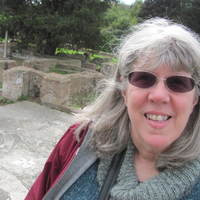With Esther Read, Field Archaeologist
 So you’re digging a garden in your backyard, and all of a sudden the point of your trowel hits something hard. You poke around a little more, brush the soil away – probably just a rock, right? But on further inspection, the “thing” you have discovered is rather glossy, with faint drawings and a whiff of history about it. When you wash it off in the sink… Voila! You have a ceramics mystery in your hands.
So you’re digging a garden in your backyard, and all of a sudden the point of your trowel hits something hard. You poke around a little more, brush the soil away – probably just a rock, right? But on further inspection, the “thing” you have discovered is rather glossy, with faint drawings and a whiff of history about it. When you wash it off in the sink… Voila! You have a ceramics mystery in your hands.
Since Antiques Road Show only comes around town once in a blue moon, you might be scratching your head about what to do next: keep it, or toss it? Thankfully, Esther Read, a field archeologist and lecturer in UMBC’s department of Ancient Studies, is here to help.
— Jenny O’Grady
Step 1:
Look for decorative clues
“If you found something on the ground, the first thing you would do is look at it for its decoration,” says Read, who – with the help of UMBC students and volunteers – is in the process of cleaning, identifying and cataloguing more than 4,000 artifacts found in the backyard of an historic Fells Point home.
The first step is taking a close look at decoration and shape. Then take a closer look; was the piece painted with a brush, or does it seem like one of many copies? Feel the ceramic with your hands; was the clay molded smooth by a machine or more roughly by an artisan’s hands? Shape can also help you understand what kind of vessel the piece once was. Each detail is a key to solving your mystery.
“The decoration is going to give you a clue to what kind of ceramic it is,” says Read.
Step 2:
Use your clues to figure out historical context
Decorative style reveals much about the time period in which the piece was created. For instance, a dish with images of giraffes painted in a certain shade of purple might indicate a piece was manufactured between 1760 and 1780 – a time when images from “exotic” lands were all the rage.
“We know what kinds of designs were done during certain periods from old catalogues, from antiques magazines and articles,” says Read. Every bit of the design comes into play – from subject matter to painting style. A pastoral scene might have been manufactured during the time when Jane Austen first became popular. The use of stippling – or sharp dotting with a paintbrush – indicates another time entirely.
Step 3:
Location, location, location
One of the biggest challenges in archaeology is combining this collection of physical clues with information about where you found the object, and the context of the time period – ie., sociological, economic, or political trends. All of these things in combination are necessary to assemble a full picture of the artifact’s life as an object. That’s why Read hastens to add one very important rule for anyone interested in reassembling the puzzle: never move the artifact away from its original location.
“An artifact has a context…its place in time and space, and its association with other artifacts,” Read says. Without that context, she continues, you might miss the point of an object entirely.
“A lot of the training in doing this is not just learning the dishes, but learning past manners and how people used the material culture of the past,” adds Read. “You need to know all of these things to paint a really good picture.”
Step 4:
Check in with the experts
Read has spent more than 25 years learning everything she can about artifacts of the Mid-Atlantic region. So, admittedly, she has a brain full of details that help her identify objects much faster than the average Joe. But, she said, there are plenty of resources out there for budding archaeologists.
“It’s accumulated knowledge, it’s shared knowledge, and it’s knowing what the printed resources are and where to find them,” she says. (See “Now What?” for some of her suggestions .)
If you want to truly solve your pottery mystery, you might also contact someone like Read at a nearby university, or visit your local historical society. People there are often more than happy to talk shop, Read said.
“I get a lot of calls that start out, ‘I’ve got a rock, can you help me?’” Read says. After some clue-gathering, however, these seemingly insignificant discoveries in the backyard often lead us to better understand our nation’s history.
“We can never go back to the past,” she says, “so we have to reconstruct it from what we find.”
Now What?
Interested in learning more about archaeology? Check out these resources:
1. A Guide to the Artifacts of Colonial America by Ivor Noël Hume – With more than 100 photographs and illustrations, this book is considered the most accurate reference guide for artifacts of this time period.
2. UMBC Ancient Studies Website – The department website at www.umbc.edu/ancs includes information on upcoming travel/study opportunities and department news, as well as a list of online databases and other resources covering everything from the Bronze Age to medieval studies to nautical archaeology.
3. Local and National Societies – Visit the Archeological Society of Maryland at www.marylandarcheology.org or the nation’s oldest such society, the Archaeological Institute of America, online at www.archaeological.org, for dig news, resources and opportunities for networking.
[youtube http://www.youtube.com/watch?v=DSllKsQAtz8]
Tags: Fall 2010, professorsnottomiss

